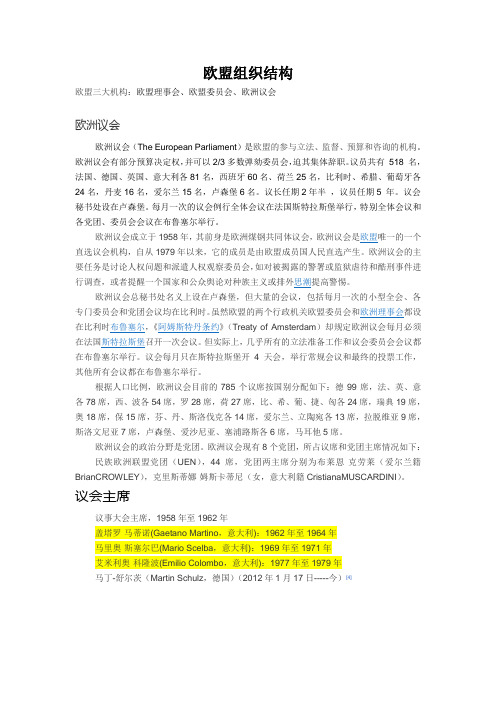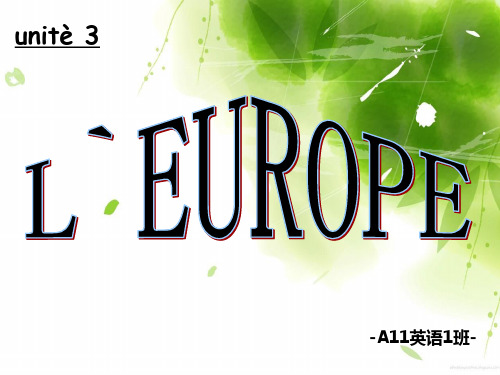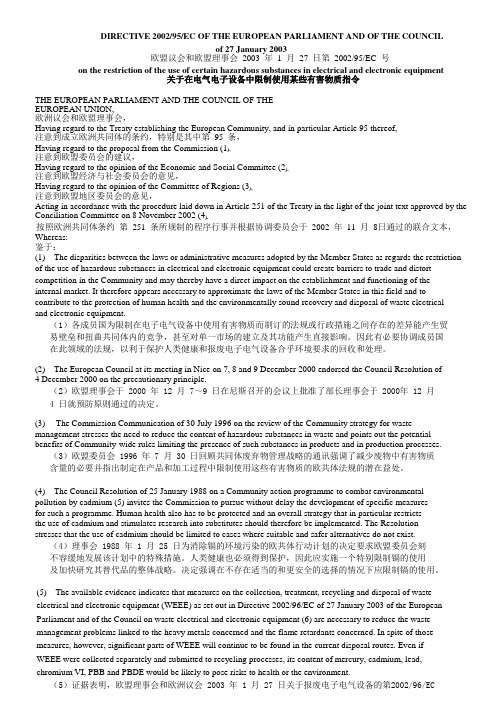欧盟与欧洲理事会【英文】
欧洲理事会、欧洲委员会、欧盟委员会间的关系

欧洲理事会、欧洲委员会、欧盟委员会间的关系
欧盟拥有三个部门机构:欧盟委员会(European Commissi on),欧盟理事会(European Council)和欧洲议会(Euro pean Parliament)。
大多数立法权集中于欧盟委员会和理事会。
这两个机构完全不民主。
第一个机构欧盟委员会,其成员不通过选举产生、亦不向选民负责,故委员会不被选民意见左右,也不会被解散。
成为委员的先决条件是,宣誓放弃对所在国家的效忠。
因此,欧盟在精英体制下非常有效率地运行,精英们可以做他们想做的事情,他们可以顺风顺水地为欧盟制定政策。
第二个机构欧盟理事会,由首相(Prime Ministers)和各成员国的总统组成,虽然总统们由各国民主选出,但他们做决定时不会咨询各国的议会,因此会像dictator一般行事。
英国人记得,戈登·布朗(Gordon Brown)曾在未通知英国国民的情况下、偷偷跑去里斯本签署了一个宪法决议,因为他知道英国人会否决它的提案。
此外,这些国家领导人没有提案的权力,他们只有向欧盟委员会下发政策进行投票的权利。
欧盟理事会,就是坐在权力顶座的非民选精英。
第三个机构欧洲议会,是唯一遵循民主原则的机构,但是其权力与另外两个机构比较要小得多。
每年,欧盟成员国都要向这个中央集权的欧盟,交付出更多的主权。
在英国已出现了几例法律变更,都是欧洲强加于英国的,英国的本土公民其实并不知道这些法律变更,并且也
不愿意支持。
英国的政治家对此很无所谓。
欧盟组织结构.

欧盟组织结构欧盟三大机构:欧盟理事会、欧盟委员会、欧洲议会欧洲议会欧洲议会(The European Parliament)是欧盟的参与立法、监督、预算和咨询的机构。
欧洲议会有部分预算决定权,并可以2/3多数弹劾委员会,迫其集体辞职。
议员共有518 名,法国、德国、英国、意大利各81名,西班牙60名、荷兰25名,比利时、希腊、葡萄牙各24名,丹麦16名,爱尔兰15名,卢森堡6名。
议长任期2年半,议员任期5 年。
议会秘书处设在卢森堡。
每月一次的议会例行全体会议在法国斯特拉斯堡举行,特别全体会议和各党团、委员会会议在布鲁塞尔举行。
欧洲议会成立于1958年,其前身是欧洲煤钢共同体议会,欧洲议会是欧盟唯一的一个直选议会机构,自从1979年以来,它的成员是由欧盟成员国人民直选产生。
欧洲议会的主要任务是讨论人权问题和派遣人权观察委员会,如对被揭露的警署或监狱虐待和酷刑事件进行调查,或者提醒一个国家和公众舆论对种族主义或排外思潮提高警惕。
欧洲议会总秘书处名义上设在卢森堡,但大量的会议,包括每月一次的小型全会、各专门委员会和党团会议均在比利时。
虽然欧盟的两个行政机关欧盟委员会和欧洲理事会都设在比利时布鲁塞尔,《阿姆斯特丹条约》(Treaty of Amsterdam)却规定欧洲议会每月必须在法国斯特拉斯堡召开一次会议。
但实际上,几乎所有的立法准备工作和议会委员会会议都在布鲁塞尔举行。
议会每月只在斯特拉斯堡开4天会,举行常规会议和最终的投票工作,其他所有会议都在布鲁塞尔举行。
根据人口比例,欧洲议会目前的785个议席按国别分配如下:德99席,法、英、意各78席,西、波各54席,罗28席,荷27席,比、希、葡、捷、匈各24席,瑞典19席,奥18席,保15席,芬、丹、斯洛伐克各14席,爱尔兰、立陶宛各13席,拉脱维亚9席,斯洛文尼亚7席,卢森堡、爱沙尼亚、塞浦路斯各6席,马耳他5席。
欧洲议会的政治分野是党团。
欧洲议会现有8个党团,所占议席和党团主席情况如下:民族欧洲联盟党团(UEN),44席,党团两主席分别为布莱恩·克劳莱(爱尔兰籍BrianCROWLEY),克里斯蒂娜·姆斯卡蒂尼(女,意大利籍CristianaMUSCARDINI)。
欧盟及其成员国

欧洲联盟(European Union),简称欧盟(EU),是由欧洲共同体(European Communities,又称欧洲共同市场) 发展而来的,是一个集政治实体和经济实体于一身、在世界上具有重要影响的区域一体化组织。
1991年12月,欧洲共同体马斯特里赫特首脑会议通过《欧洲联盟条约》,通称《马斯特里赫特条约》(简称《马约》)。
1993年11月1日,《马约》正式生效,欧盟正式诞生。
欧盟现有27个成员国和近5亿人口(2007年1月),总部设在比利时首都布鲁塞尔。
欧盟的宗旨是“通过建立无内部边界的空间,加强经济、社会的协调发展和建立最终实行统一货币的经济货币联盟,促进成员国经济和社会的均衡发展”,“通过实行共同外交和安全政策,在国际舞台上弘扬联盟的个性”。
【成立过程】欧洲统一思潮存在已久,在第二次世界大战后进入高潮。
1946年9月,英国首相丘吉尔曾提议建立“欧洲合众国”。
1950年5月9日,法国外长罗伯特·舒曼提出欧洲煤钢共同体计划(即舒曼计划),旨在约束德国。
1951年4月18日,法、意、联邦德国、荷、比、卢六国签订了为期50年的《关于建立欧洲煤钢共同体的条约》。
1955年6月1日,参加欧洲煤钢共同体的六国外长在意大利墨西拿举行会议,建议将煤钢共同体的原则推广到其他经济领域,并建立共同市场。
1957年3月25日,6国外长在罗马签订了建立欧洲经济共同体与欧洲原子能共同体的两个条约,即《罗马条约》,于1958年1月1日生效。
1965年4月8日,6国签订了《布鲁塞尔条约》,决定将欧洲煤钢共同体、欧洲原子能共同体和欧洲经济共同体统一起来,统称欧洲共同体。
条约于1967年7月1日生效。
欧共体总部设在比利时布鲁塞尔。
1991年12月11日,欧共体马斯特里赫特首脑会议通过了建立“欧洲经济货币联盟”和“欧洲政治联盟”的《欧洲联盟条约》(通称马斯特里赫特条约,简称“马约”)。
1992年2月1日,各国外长正式签署马约。
eu

【欧盟简介】欧洲联盟(简称欧盟,European Union -- EU)是由欧洲共同体 (European communities) 发展而来的,是一个集政治实体和经济实体于一身、在世界上具有重要影响的区域一体化组织。
1991年12月,欧洲共同体马斯特里赫特首脑会议通过《欧洲联盟条约》,通称《马斯特里赫特条约》(简称《马约》)。
1993年11月1日,《马约》正式生效,欧盟正式诞生。
总部设在比利时首都布鲁塞尔。
2003年7月,欧盟制宪筹备委员会全体会议就欧盟的盟旗、盟歌、铭言与庆典日等问题达成了一致。
根据宪法草案:欧盟的盟旗仍为现行的蓝底和12颗黄星图案,盟歌为贝多芬第九交响曲中的《欢乐颂》,铭言为“多元一体”,5月9日为“欧洲日”。
欧盟的会旗:1986年5月29日正式悬挂,会旗为天兰色底,上面有12颗金黄色的星,表示欧洲联盟12个成员国。
制作会旗的目的是表示要建立一个统一的欧洲,增强人们对欧洲联盟和欧洲同一性的印象。
欧盟的会徽:1988年1月开始使用,会徽的底呈兰色,上面12颗星围成一个圆圈,象征着欧共体12个成员国,圆圈中间为各成员国国名。
欧盟的盟歌:贝多芬第九交响曲中的《欢乐颂》。
欧洲议会重新启用盟旗盟歌等欧盟标志欧盟将增加官方语言欧盟的铭言:“多元一体”。
欧盟的统一货币:欧元 (euro),1999年1月1月1日零时,欧元正式流通。
截至2009年1月,欧元区成员国有16个。
欧盟的主要出版物:《欧洲联盟公报》、《欧洲联盟月报》、《欧洲文献》、《欧洲新闻—对外关系》和《欧洲经济》等。
【成立过程】1946年9月,英国首相丘吉尔曾提议建立“欧洲合众国”。
1950年5月9日,当时的法国外长罗贝尔·舒曼(1886年-1963年)代表法国政府提出建立欧洲煤钢联营。
这个倡议得到了法、德、意、荷、比、卢6国的响应。
1951年4月18日,法国、联邦德国、意大利、荷兰、比利时和卢森堡在巴黎签订了建立欧洲煤钢共同体条约(又称《巴黎条约》)。
欧的组织词

欧的组织词
欧的组织词指的是以“欧”为词根的组织名称。
这些组织通常都是由欧洲国家或地区组成的,旨在促进欧洲国家间的合作和发展。
以下是一些常见的欧的组织词:
1. 欧洲联盟(European Union,简称EU):该组织是由27个欧洲国家组成的政治和经济联盟,旨在促进成员国之间的合作和一体化。
2. 欧洲经济区(European Economic Area,简称EEA):该组织是由欧洲联盟成员国和欧洲自由贸易联盟成员国组成的经济区,旨在促进贸易自由化和经济一体化。
3. 欧洲理事会(European Council):该组织是欧洲联盟的高级别政治机构,由成员国的国家元首或政府首脑组成,主要负责制定欧洲联盟的政治议程和指导政策。
4. 欧洲议会(European Parliament):该组织是欧洲联盟的立
法机构,由欧洲各国选出的议员组成,主要负责审议和制定欧洲联盟的法律。
5. 欧洲委员会(European Commission):该组织是欧洲联盟的
执行机构,由27名委员组成,负责监督欧洲联盟的政策和法律的执行。
6. 欧洲投资银行(European Investment Bank,简称EIB):该组织是欧洲联盟的金融机构,旨在为欧洲国家提供贷款和资金支持,以促进欧洲的经济发展。
7. 欧洲自由贸易联盟(European Free Trade Association,简
称EFTA):该组织是由欧洲的非欧盟国家组成的自由贸易区,旨在促进成员国之间的贸易自由化和合作。
L`EUROPE(1)

une superficie de
词组
1、à partir de: 从……开始 A partir d`aujourd`hui, je fais le mènage, tu fais la cuisine. 从今天开始,我做家务,你做饭。
partir vi.出发,开始 je pars tu pars il/elle part nous partons vous partez ils/elles partent
unitè 3
-A11英语1班-
L'Union Européenne Créée en 1952 à partir de six États, l'Union européenne s'est élargie àneuf, à quinze puis à 25 et, depuis 2007, l'UE regroupe 27 États, soit plus de 492 millions d'habitants avec une superficie de 4 280 000 km2. 欧盟成立于1952年,当时有6个成员国,后来扩大 到9个、15个、然后是25个,2007年有27个成员 国。欧盟聚集了超过4.92亿居民,拥有428万平方 公里的面积。 La Commission européenne et le Conseil de l'Union européenne sont situés àBruxelles. 欧洲委员会和欧盟理事会位于布鲁塞尔。
-- 2 0 1 1
பைடு நூலகம்
倾 情 出 品 --
1991年12月,欧洲共同体马斯特 里赫特首脑会议通过《欧洲联盟 条约》,通称《马斯特里赫特条 约》(简称《马约》)。1993年 11月1日,《马约》正式生效,欧 盟正式诞生。2012年,欧盟获得 诺贝尔和平奖。欧洲理事会主席 为范龙佩。欧盟委员会主席为巴 罗佐。
The European Union

The European Union欧盟(The European Union)的前身是欧洲共同体(简称“欧共体”)。
1951年4月18日,法国、联邦德国、意大利、荷兰、比利时和卢森堡6国在法国首都巴黎签署关于建立欧洲煤钢共同体条约(又称《巴黎条约》),1952年7月25日,欧洲煤钢共同体正式成立。
1957年3月25日,法国、联邦德国、意大利、荷兰、比利时和卢森堡6国在意大利首都罗马签署旨在建立欧洲经济共同体和欧洲原子能共同体的条约(又称《罗马条约》)。
1958年1月1日,欧洲经济共同体和欧洲原子能共同体正式组建。
1965年4月8日,法国、联邦德国、意大利、荷兰、比利时和卢森堡6国在比利时首都布鲁塞尔又签署《布鲁塞尔条约》,决定将欧洲煤钢共同体、欧洲经济共同体和欧洲原子能共同体合并,统称“欧洲共同体”。
1967年7月1日,《布鲁塞尔条约》生效,欧共体正式诞生。
1973年英国、丹麦和爱尔兰加入欧共体。
1981年希腊加入欧共体,成为欧共体第十个成员国。
1986年葡萄牙和西班牙加入欧共体,使欧共体成员国增至12个。
1993年11月1日,根据内外发展的需要,欧共体正式易名为欧洲联盟。
1995年奥地利、瑞典和芬兰加入欧盟。
2002年11月18日,欧盟15国外长在布鲁塞尔举行会议,决定邀请马耳他、塞浦路斯、波兰、匈牙利、捷克、斯洛伐克、斯洛文尼亚、爱沙尼亚、拉脱维亚、立陶宛等十个国家加入欧盟。
2003年4月16日,在希腊首都雅典举行的欧盟首脑会议上,上述十国正式签署加入欧盟协议。
2004年5月1日,十个新成员国正式加入欧盟。
2004年10月,欧盟25国首脑在意大利首都罗马签署了《欧盟宪法条约》。
这是欧盟的首部宪法条约,旨在保证欧盟的有效运作以及欧洲一体化进程的顺利发展。
2005年,法国和荷兰先后在全民公决中否决了《欧盟宪法条约》。
2007年1月1日,罗马尼亚,保加利亚加入欧盟。
2007年6月,参加欧盟峰会的27国首脑在布鲁塞尔就替代《欧盟宪法条约》的新条约草案达成协议。
欧盟立法

欧 盟 委 员 会
是欧盟唯一有权起草法令的机构,其主要职 责是:实施欧盟有关条约、法规和欧盟理事 会做出的决定;向欧盟理事会和欧洲议会提 出政策实施报告和立法动议;处理欧盟日常 事务,代表欧盟进行对外联系和贸易等方面 的谈判。委员会总部设在布鲁塞尔,委员会 任期为5年。欧盟委员会在每届欧洲议会选 丼后的6个月内任命,它在政治上向议会负 责,议会有权通过弹劾委员会的动议而解散 它。
ห้องสมุดไป่ตู้
欧 盟 立 法 主 要 机 构
欧盟的立法必须涉及到几个主要机构, 特别是: 欧盟委员会(The European Commission); 欧洲议会(The European Parliament EP); 欧盟理事会(The Council of the European Union)。
一般由欧盟委员会提出新的立法 建议,但要由理事会和议会通过才能 形成法律。其它的组织和机构也可以 参与立法过程。
3.废除程序(Actions for annulment) 如果某个成员国、或欧盟理事会、欧盟委员 会或欧洲议会认为某个欧盟法律不合法,他们可 以要求欧洲法院废除该法律。 这种废除程序也可以用于个体,如果因为某 项特殊法律直接影响到他们本人,他们可以要求 法院废除该法律。 如果法院发现质疑中的法律确实不能正确地 加以实施,它会宣布该法律无效。 4.对错误决策的纠正程序(Actions for failure to act) 条约要求欧洲议会、理事会和欧盟委员会在 特定的环境下制定特定的政策。如果他们没有这 样做,成员国或其它组织机构、个人或公司都可 以向法院提起上诉,通过法律来加以纠正。
2.同意(Assent)
同意程序指,在某项重要的决策 确定之前,理事会必须得到欧洲议会 的同意。 同意程序与咨询程序的情况一样, 除非议会不同意修改委员会提出的建 议:它必须接受该建议或者拒绝该建 议。接受(即同意)需要得到绝大多数 议会代表的投票。
国际组织名称 翻译

African Development Fund 非洲开发基金ADFAfrican Groundnut Council 非洲花生理事会AGCAfrican Liberation Committee 非洲解放委员会African Postal Union 非洲邮政联盟AFPUAfrican Postal and Telecommunication Union 非洲邮政电信联盟APU/ATUAfrican Timber Organization 非洲木材组织ATOAgency for the Protection of Number weapons in Latin America 拉丁美洲禁止核武器组织OPANALAmerican International Chamber of Commerce 美国国际商会Andean Pact Organization 安第斯条约组织(安第斯集团)Andean GroupAndean Reserve Fund 安第斯储备基金会FARAnzus Council 澳新美理事会Arab African International Bank 阿拉伯-非洲国际银行Arab Common Market 阿拉伯共同市场Arab Fund for Economic and Social Development 阿拉伯经济和社会发展基金会AFESDArab Inter-Parliamentary Union 阿拉伯议会联盟AIPUArab-Latin American Bank 阿拉伯-拉丁美洲银行ARLABANKArab Monetary Fund 阿拉伯货币基金组织AMFArab Organization for Standardization and Metrology 阿拉伯标准化和计量组织ASMOArab States Broadcasting Union 阿拉伯国家广播联盟ASBUArab Summit Conference 阿拉伯国家首脑会议ASEAN Regional Forum 东盟地区论坛ARFAsian-African Conference(Bandung Conference)亚非会议(万隆会议)Asian and Pacific Coconut Community 亚洲和太平洋椰子共同体APCCAsian Cleaning Union 亚洲清算联盟ACUAsian Development Bank 亚洲开发银行ADBAssociation of Iron Ore Exporting Countries 铁矿砂出口国协会APEFAssociation of Natural Rubber Producing Countries 天然橡胶生产国协会ANRPC Association of Southeast Asian Nations 东南国家联盟(东盟)ASEANAsian Organization of Supreme Audit Institution 亚洲最高审计组织ASOSAIBank of the Central African States 中非国家银行EBACBenelux Economic Union 比荷卢经济联盟Caribbean Community 加勒比共同体Caribbean Multinational Shipping Company 加勒比多国海运公司Cartagena Group 卡塔赫纳集团Central African Monetary Union 中非货币同盟Central American Bank of Economic Integration 中美洲经济一体化银行BCIE Central American Common Market 中美洲共同市场CACMCivil Aviation Council of Arab States 阿拉伯国家民用航空理事会CACAS Commission of the Cartagena Agreement 卡塔赫纳协定委员会JUNAC Commonwealth 英联邦Cocoa Producer’s Alliance 可可生产者联盟CPACommon Market for Eastern and Southern Africa 东部和南部非洲共同市场COMESA 独立国家联合体CISConference of Non-Aligned Countries 不结盟国家会议Conference on Confidence and Security-Building Measures and Disarmament in Europe (Conference on Disarmament in Europe) 在欧洲建立信任与安全措施和裁军会议(欧洲裁军会议)Consultative Assembly Between the African Caribbean and Pacific State (ACP) and the European Economic Community (EEL) 非洲、加勒比和太平洋地区国家-欧洲经济共同体咨询会议Contadora Group 孔塔多拉集团Co-ordinating Committee for Export to Communist Countries 巴黎统筹委员会COCOMCoordination Bureau of the Non-Aligned Countries 不结盟国家协调局Council for Cultural Cooperation 文化合作理事会CCCCouncil for Mutual Economic Assistance 经济互助委员会(经互会)CMEACouncil of Arab Economic Unity 阿拉伯经济统一体理事会CAEUCustoms Cooperation Council 海关合作理事会CCCDanube Commission 多瑙河委员会Desert Locust Control Organization for Eastern Africa 东非控制沙漠蝗虫组织DLCO-EAEast African Community 东非共同体EACEAST ASIA-LATIN AMERICA FORUM 东亚-拉美论坛EALAFEconomic Commission for Africa 非洲经济委员会ECAEconomic and Social Commission for Asia and the Pacific 亚洲及太平洋经济社会委员会ESCAPEconomic Commission for Europe 欧洲经济委员会ECEEconomic Commission for Latin America and the Caribbean 拉丁美洲和加勒比经济委员会ECLAEconomic and Social Commission for Western Asia 西亚经济社会委员会ECWAEconomic Community of Central African States 中非国家经济共同体CEEACEconomic Community of the Great Lakes Countries 大湖国家经济共同体CEPGLEconomic Community of West African States 西非国家经济共同体ECOWASEuropean Atomic Energy Community 西欧原子能共同体EURATOMEuropean Coal and Steel Community 西欧煤钢共同体ECSCEuropean Conference of Ministers of Transport 欧洲交通部长会议ECMTEuropean Communities 欧洲共同体ECEuropean Economic and Monetary Union 欧洲经济和货币同盟EMUEuropean Free Trade Association 欧洲自由贸易联盟EFTAEuropean Investment Bank 欧洲投资银行EIBEuropean Monetary Cooperation Fund 欧洲货币合作基金组织EMCFEuropean Organization for Nuclear Research 欧洲核研究组织CERNEuropean Organization for the Safety of Air Navigation 欧洲航行安全组织EUROCONIROLEuropean Space Agency 欧洲航天局ESAEuropean Union 欧洲联盟EUFood Aid Committee 粮食援助委员会Food and Agriculture Organization of the United Nations 联合国粮食及农业组织FAOFrance-African Summit Conference 法国-非洲国家首脑会议French Community 法兰西共同体General Agreement on Tariffs and Trade 关税和贸易总协定GATTGeneva Conference on Disarmament 日内瓦裁军谈判会议CDGroup of Africa,Caribbean and Pacific Region Countries 非洲、加勒比和太平洋地区国家集团Group of ACPGroup of Latin American and Caribbean Sugar Exporting Countries 拉丁美洲和加勒比糖出口国集团GEPLACEAGroup of 77 七十七国集团Group of Ten (Paris Club) 十国集团(巴黎俱乐部)Group of Twenty Four 二十四国集团Jerusalem Committee 耶路撒冷委员会Join Institute for Nuclear Research 联合原子能研究所JINBIndian Ocean Rim Association for Regional Cooperation 环印度洋地区合作联盟Inter-African Coffee Organization 中非国家咖啡组织IACOInter-American Development Bank 泛美开发银行IDBInter-American Nuclear Energy Commission 美洲国家核能委员会IANEC Intergovernmental Bureau for Informatics 政府间信息局IBIIntergovernmental Committee for Migration 政府间移民委员会ICMIntergovernmental Copyright Committee 政府间版权委员会ICCIntergovernmental Council of Copper Exporting Countries 铜出口政府间委员会CIPEC International Association of Mercury Producer 国际水银生产者协会International Atomic Energy Agency 国际原子能机构IAEAInternational Bank for Reconstruction and Development 国际复兴开发银行(世界银行)IBRD 或World BankInternational Bauxite Association 国际铝矾土协会IBAInternational Bureau of Education 国际教育局IBEInternational Bureau of Weight and Measures 国际计量局BIPMInternational Cable Protection Committee 国际电缆保护委员会ICPCInternational Civil Aviation Organization 国际民用航空组织ICAOInternational Civil Defence Organization 国际民防组织ICDO International Cocoa Organization 国际可可组织ICCO International Coffee Organization 国际咖啡组织。
欧盟组织结构

欧洲理事会(欧盟首脑会议或欧盟峰会)European Council主席:赫尔曼·范龙佩Herman Van Rompuy欧盟理事会(部长理事会或理事会)Council of the European Union秘书长:乌韦·科塞庇乌斯Uwe CORSEPIUS欧盟委员会(欧委会或委员会)European Commission主席:若泽·曼努埃尔·巴罗佐JoséManuel BARROSO 欧洲议会European Parliament议长:马丁·舒尔茨Martin Schulz欧盟对外行动署European External Action Service(EEAS)高级代表:Catherine Ashton欧洲联盟法院(欧洲法院)The Court of Justice院长:Vassilios Skouris欧盟审计院The Court of Auditors主席:Vítor Manuel da Silva Caldeira欧洲经济和社会委员会(经社委员会)The European Economic and Social Committee(ESC)主席:Staffan Nilsson欧洲地区委员会The Committee of the Regions(CoR)主席:Ramón Luis Valcárcel Siso 欧盟中央银行The European Central Bank行长:马里奥·德拉吉Mario Draghi欧盟投资银行The European Investment Bank行长:Werner Hoyer欧盟特派员European OmbudsmanNikiforos Diamandouros轮值主席国塞浦路斯(2012年下半年)、爱尔兰(2013年上半年)、立陶宛(2013年下半年)欧盟数据保管中心European Data Protection Supervisor 主任:Peter Hustinx欧盟人员甄选办公室European Personnel Selection Office 主任:Mr. David Bearfield。
欧盟主席和欧盟理事会主席是什么关系?谁大?

欧盟主席和欧盟理事会主席是什么关系?谁大?
纠正一下是欧盟委员会主席和欧洲理事会主席
欧盟委员会主席:
欧盟委员会主席(英语:The President of the European Commission)是欧盟委员会的主席,欧盟行政机关最高执行官,亦可称为“欧盟总理”,是欧盟的政府首脑。
1958年首次设立该职位,并根据欧洲议会选举结果而提名,欧洲理事会经选举产生,一届任期5年。
当选后,他和他领导的欧盟委员会必须对欧洲议会负责。
欧盟委员会主席是负责分配、组合委员会的成员,同时可以改组或解雇他们。
如果需要他也能决定委员会的政策议程和所有立法提案的产生。
欧盟委员会主席也是欧盟在外的代表,与欧洲理事会主席和欧盟外交和安全政策高级代表同级别。
然而欧盟委员会主席不像一个正常的政府首脑,没有对国防、外交、内政及财政政策的绝对权力,须与欧盟外交与安全政策高级代表共同执行,以及命令部队权力或提高税收权力。
欧洲理事会主席:
欧洲理事会主席(英语:President of the European Council)是欧洲理事会中作为欧盟国家元首的角色,负责主持和推动其在欧盟的相关事务,同时也是欧盟在世界舞台上对外的主要代表。
过去由欧盟主席国的国家元首及政府首脑每半年轮流出任,在里斯本条约签署后设立常任的主席,俗称“欧盟总统”,任期为两年半,可以连任一次,取代轮值欧盟国家主席国制度。
欧盟机构名称汉法互译和解释

欧盟机构名称汉法互译和解释欧洲联盟Union européenne简称:欧盟(UE); European Union[英]欧洲理事会Conseil européen俗称:欧盟首脑理事会;系欧盟各成员国首脑每半年一次会晤的机制;先前由各成员国首脑轮流担任主席,即所谓的轮值主席(任期半年);2010年1月起将改为由欧洲理事会常设主席。
欧洲联盟理事会Conseil de l’Union européenne简称:欧盟理事会;俗称:欧盟部长级理事会。
其级别低于欧洲理事会(欧盟首脑会议机制);欧洲联盟理事会原称部长理事会,是欧盟决策机构,拥有其绝大部分立法权。
欧洲理事会(常设)主席Président du Conseil européen欧盟委员会Commission européenne欧盟常设执行机构。
负责实施欧共体条约和理事会作出的决定,向理事会和欧洲议会提出报告和建议,处理欧盟日常事务,代表欧盟进行对外联系和贸易等方面的谈判。
委员会由许多委员组成。
主席由首脑会议任命,任期 2 年;委员由部长理事会任命,任期4年。
欧洲议会Parlement européen欧盟监督、咨询机构。
有部分预算决定权,可以2/3多数弹劾委员会,迫其集体辞职。
议员共有数百名。
议长任期2年半,议员任期 5 年。
议会秘书处设在卢森堡。
每月一次的议会例行全体会议在法国斯特拉斯堡举行,特别全体会议和各党团、委员会会议在布鲁塞尔举行欧洲委员会Conseil de l’Europe泛欧洲组织,成立于1949年,现有东西欧47个成员国;主要通过法律手段促进欧洲建设,维护人权、民主、法制;该组织与欧盟(政治、经济一体化组织)无关系,在国际上的影响也远不及“欧盟”,两者不得混淆。
欧洲六大区域组织中英文对照

欧洲委员会(Council of Europe,简称欧委会)于1949年5月5日在伦敦成立,原为
西欧10个国家组成的政治性组织,现已扩大到整个欧洲范围,共有47个成员国,以及5个部长委员会观察员国(梵蒂冈、加拿大、美国、日本和墨西哥)以及3个议会观察员国(加拿大、墨西哥和以ion),简称欧盟(EU),总部设在比利时首都布鲁塞尔,是由欧洲共同体 (European Community,又称欧洲共同市场)发展而来的,主要经历了三个阶段:荷卢比三国经济联盟、欧洲共同体、欧盟。其实是一个集政治实体和经济实体于一身、在世界上具有重要影响的区域一体化组织。1991年12月,欧洲共同体马斯特里赫特首脑会议通过《欧洲联盟条约》,通称《马斯特里赫特条约》(简称《马约》)。1993年11月1日,《马约》正式生效,欧盟正式诞生。欧洲联盟(欧盟)是一个政治和经济共同体的27会员国。
欧洲理事会(The European Council),也被称为欧盟首脑会议、欧盟高峰会或欧洲高峰会,是由欧盟27个成员国的国家元首或政府首脑与欧盟委员会主席共同参加的首脑会议。它是欧盟事实上的最高决策机构、但不列入欧盟机构序列当中。各国的外长和欧盟委员也会出席欧洲理事会。最早的欧洲理事会由前法国总统德斯坦提议成立于1974年,当时被称之为欧洲经济体首脑会议。欧洲理事会通常一年举行两次。在特殊情况下,欧洲理事会轮值主席国也能在其国家召开欧盟领导人非正式会议。 欧洲理事会决定欧盟的大政方针,尤其是外交方面的决策。每隔5年,新的欧盟委员会主席也由欧洲理事会任命。
欧洲议会(European Parliament),是欧盟两院制立法机关的下议院,唯一的一个直选议会机构;与欧盟理事会为是欧盟的主要决策机构。欧洲议会的前身是1952年成立的欧洲煤钢共同体议会,当时由法国、西德、意大利、荷兰、比利时、卢森堡6个成员国的78名议员组成,1962年改称“欧洲议会”,它是欧盟三大机构(欧盟理事会、欧盟委员会、欧洲议会)之一,为欧盟的立法、监督和咨询机构。
欧洲理事会、欧盟理事会、欧盟委员会、欧洲委员会有什么区别?上

欧洲理事会、欧盟理事会、欧盟委员会、欧洲委员会有什么区别?上大家在看和欧洲有关的新闻时,有没有被“欧洲理事会”“欧盟理事会”“欧盟委员会”“欧洲委员会”这四个名词弄晕过?这四个词好像啊,它们是一个名词的多种译法吗?如果不是的话,那这四个机构之间有什么关系和区别呢?下面来为大家进行一个科普!这四个名词指的是四个机构吗?答案是,当然!这是四个完全不同的机构。
让我们来看看这四个名词的英文。
欧洲理事会——European Council欧盟理事会——Council of the European Union欧盟委员会——European Commission欧洲委员会——Council of Europe也许大家会说,这四个英文也好像啊!好吧,其实不仅中国人,就连很多欧洲人都在吐槽这四个名字也太容易让人混淆了。
那么现在,让我们不要纠结于这四个机构是如何命名和翻译的,而是首先了解一下它们的作用和职责。
也许在了解过后,大家就能更容易理解为何这四个机构要如此命名,他们的名称都分别代表了什么含义。
这四个机构都是欧盟机构吗?答案是,否!!有欧洲理事会、欧盟理事会、欧盟委员会属于欧盟机构,欧洲委员会则是完全不同的另一个机构(更准确的讲,应该是一个独立于欧盟的国际组织)。
既然欧洲委员会和其他三者属于完全不同的一个体系,那就让我们首先讲讲欧洲委员会吧!欧洲委员会(Council of Europe)是什么?根据维基百科的定义,欧洲委员会是一个创建于1949年,拥有47个成员国(全部为欧洲国家)的国际组织,其作用是维护欧洲的人权、民主和法治。
所以,欧洲委员会其实和欧盟一样是一个国际组织,而上述其他三者则是从属于欧盟的机构!欧洲委员会的logo但请注意,这个似乎没有什么存在感的国际组织,成立的时间甚至要早于欧共体(欧盟的前身)。
这是因为某种程度上来说,欧洲委员会是欧洲一体化的第一次尝试(如果不算敦刻尔克条约组织等军事同盟的话)。
欧洲共同体机构

欧洲议会选举
欧洲议会实行直接选举始于1979年,在此之前,欧洲议会 的议员由各成员国的议会指派。欧盟各成员国根据分配的名额, 通过直接普选选出各自的议员参加欧洲议会。选举结束后,全 部议员将按党派而不是国籍组成不同党团。 • 议员的任期为5年。欧洲议会设议长一名,副议长14名,均 由议员选举产生,任期两年半,可以连选连任。 • 由于欧盟各国许多政党领导人和政界知名人士当选议员,欧洲 议会具有较广泛的代表性,在加强欧洲各国之间的了解、协调 和合作中发挥了积极的作用。
•
• • •
欧盟理事会
• 欧盟理事会是一个由来自欧盟成员国各国政府部 长所组成的理事会,是欧盟的主要决策机构之一。 每一个国家在理事会中都有一名代表(“理 事”),在2004年罗马条约签署之后,通常也称 之为“部长理事”,目的是为了把他和欧洲理事 会的理事即国家元首或政府首脑区分开来。欧盟 理事会正式的具体名称应该是“欧共体理事会”, 不过这一名称使用并不广泛。欧盟理事会俗称欧 盟部长理事会,在欧盟官方内部也简称“理事 会”。欧盟理事会在没有特殊情况下,通常在比 利时首都布鲁塞尔召开。
3 共同体机构
委员会 欧盟理事会 欧洲理事会 欧洲议会 审计院 法院
委员会 (Commission )
欧盟委员会 (Commission of European Union) :是欧盟的执 行机构,负责起草欧盟法规,实施欧盟条约、法规和理事会决 定、向理事会提出立法动议并监督其执行情况。代表欧盟负责 对外联系及经贸谈判,对外派驻使团。实行集体领导和多数表 决制。 • 委员会由1位主席(巴罗佐)、5位副主席,27位委员组 成。欧盟现行的《尼斯条约》规定,欧盟委员会主席一职需要 由欧盟27个成员国最高元首组成的理事会提出一个候选人, 之后由欧洲议会批准通过。委员由成员国政府推荐,并征得欧 洲议会同意,任期5年。委员会下设37个总司或专门的服务 处。总部设在比利时首都布鲁塞尔法律大街200号一座十字 形的大厦内。现任欧盟委员会主席巴罗佐,2004年11月 上任。 •
欧盟机构PPT

It is the EUthree bodies (Council of the European Union, the European Commission, the European Parliament), EU legislation, supervision and consulting agencies. 欧洲理事会(The European Council)是由欧盟27个成员国的国家元首或政府首脑与欧 盟委员会主席共同参加的首脑会议。 欧洲理事会决定欧盟的大政方针,尤其是外交方面 的决策。每隔5年,新的欧盟委员会主席也由欧洲理事会任命。 Council of Europe (The European Council), jointly attended by the heads of state or heads of government of the 27 EU member states and the European Commission President. The European Council decided to major policies of the European Union, especially the diplomatic aspects of the decision-making. Every five years, the new President of the European Commission is appointed by the Council of Europe. 欧洲法院 (European Court of Justice) 是欧盟的仲裁机构,负责审理和裁决在执行欧盟 条约和有关规定中发生的各种争执。现有15名法官和9名检察官,由成员国政府共同 任命。 The European Court of Justice (European Court of Justice) is the European Union's arbitration institutions responsible for hear and decide all disputes arising in the implementation of the Treaty on European Union and the relevant provisions. 15 judges and nine prosecutors, appointed jointly by the member governments.
EU 2002-95-EC中英文

DIRECTIVE 2002/95/EC OF THE EUROPEAN PARLIAMENT AND OF THE COUNCILof 27 January 2003欧盟议会和欧盟理事会2003 年 1 月27 日第2002/95/EC 号on the restriction of the use of certain hazardous substances in electrical and electronic equipment关于在电气电子设备中限制使用某些有害物质指令THE EUROPEAN PARLIAMENT AND THE COUNCIL OF THEEUROPEAN UNION,欧洲议会和欧盟理事会,Having regard to the Treaty establishing the European Community, and in particular Article 95 thereof,注意到成立欧洲共同体的条约,特别是其中第95 条,Having regard to the proposal from the Commission (1),注意到欧盟委员会的建议,Having regard to the opinion of the Economic and Social Committee (2),注意到欧盟经济与社会委员会的意见,Having regard to the opinion of the Committee of Regions (3),注意到欧盟地区委员会的意见,Acting in accordance with the procedure laid down in Article 251 of the Treaty in the light of the joint text approved by the Conciliation Committee on 8 November 2002 (4),按照欧洲共同体条约第251 条所规制的程序行事并根据协调委员会于2002 年11 月8日通过的联合文本,Whereas:鉴于:(1) The disparities between the laws or administrative measures adopted by the Member States as regards the restriction of the use of hazardous substances in electrical and electronic equipment could create barriers to trade and distort competition in the Community and may thereby have a direct impact on the establishment and functioning of theinternal market. It therefore appears necessary to approximate the laws of the Member States in this field and to contribute to the protection of human health and the environmentally sound recovery and disposal of waste electricaland electronic equipment.(1)各成员国为限制在电子电气设备中使用有害物质而制订的法规或行政措施之间存在的差异能产生贸易壁垒和扭曲共同体内的竞争,甚至对单一市场的建立及其功能产生直接影响。
欧洲理事会

欧洲理事会欧洲理事会目录简介各项制度欧洲理事会主席轮值制欧洲理事会主席改革举行过程组成与其他欧盟体制的关系简介各项制度欧洲理事会主席轮值制欧洲理事会主席改革举行过程组成与其他欧盟体制的关系展开编辑本段简介欧洲理事会(The European Council),也被称为欧盟首脑会议、欧盟高峰会或欧洲高峰会,是由欧盟27个成员国的国家元首或政府首脑与欧盟委员会主席共同参加的首脑会议。
它是欧盟事实上的最高决策机构、但不列入欧盟机构序列当中。
各国的外长和欧盟委员也会出席欧洲理事会。
最早的欧洲理事会由前法国总统德斯坦提议成立于1974年,当时被称之为欧洲经济体首脑会议。
欧洲理事会通常一年举行两次。
在特殊情况下,欧洲理事会轮值主席国也能在其国家召开欧盟领导人非正式会议。
欧洲理事会决定欧盟的大政方针,尤其是外交方面的决策。
每隔5年,新的欧盟委员会主席也由欧洲理事会任命。
编辑本段各项制度欧洲理事会主席轮值制欧洲理事会实行轮值主席国制,每个国家任期半年。
在每年的1月1日和7月1日轮换主席国。
由轮换主席国的国家元首或政府首脑出任欧洲理事会轮值主席。
欧洲理事会主席改革在2004年罗马签订的《欧盟宪法》提出未来的欧洲理事会主席将通过选举方式产生,任期为两年半。
这个改革的主要原因是:欧盟在2004年和2007年连续扩大之后,拥有的27个成员国的欧洲理事会轮值主席国制度难以继续实行,每个国家要每隔13年半才能轮值主席国一次[2]。
2009年11月,时任比利时首相范龙佩当选首任非轮值主席。
举行过程直至2004年,欧洲理事会通常在轮值主席国的某个城市举行,每次会议长达两天。
2003年《尼斯条约》签署之后,规定一年中两次欧洲理事会必须在布鲁塞尔举行,所以2004年5月以后所有的欧洲理事会都在布鲁塞尔举行。
每次理事会举行之后,轮值主席国公布会议的决定,这些决定随后必须向欧盟委员会以提议的方式提出,然后由欧洲议会表决。
只有在欧洲议会表决通过之后,这些决定才会具有真正的法律意义。
- 1、下载文档前请自行甄别文档内容的完整性,平台不提供额外的编辑、内容补充、找答案等附加服务。
- 2、"仅部分预览"的文档,不可在线预览部分如存在完整性等问题,可反馈申请退款(可完整预览的文档不适用该条件!)。
- 3、如文档侵犯您的权益,请联系客服反馈,我们会尽快为您处理(人工客服工作时间:9:00-18:30)。
The European flag represents both the Council of Europe and the European Union to strengthen the idea of solidarity between the different organizations for a united and democratic Europe
1951
Treaty of Paris
(Concluded formation of the ECSC)
1957
Treaty of Rome
(‘the EC Treaty’) Determined the legal framework of the European Community.
1992
Treaty of Maastricht
Introduction to The European Union and
The Council of Europe
Legal and Policy Frameworks
Stefaan G.Verhulst, Markle Foundation
August 2003
Outline
• EU versus CoE • Institutions, Policy Tools and Processes of the European Union • Institutions, Policy Tools and Processes of the Council of Europe • EU and CoE
Created the European Union
1997
Treaty of Amsterdam
Further developed the EU Gave Parliament co-decision powers in the EC’s legislative process
Created the European Atomic Energy Community (Euratom) and the European Community (EEC)
The European Union
The European Communities Common Foreign and Security Policy Cooperation in Justice and Home Affairs •Cooperation between judicial authorities in civil and criminal law •Police cooperation •Combating racism and xenophobia •Fighting drugs and the arms trade •Fighting organised crime •Fighting terrorism
EU Membership
Current Members Austria, Belgium,
Denmark, Finland, France, Germany, Greece, Italy, Ireland, Luxembourg, the Netherlands, Portugal, Spain, Sweden, the United Kingdom
Distinguish the EU from the CoE
Brussels
Strasbourg
European Union
15 member states (14 pending)
Council of Europe
45 member states
EU
Member States cede some of their sovereign rights to the EC. Thus, the EC is able to issue sovereign acts that have the same force as laws in individual states.
Future Members
Bulgaria, Cyprus, the Czech Republic, Estonia, Hungary, Latvia, Lithuania, Malta, Poland, Romania, Slovakia, Slocountries
CoE
Decisions require unanimity, which means that every country has a power of veto. The Council of Europe is therefore designed only with international cooperation in mind.
Foreign Policy •Cooperation, common positions and measures •Peacekeeping •Human rights •Democracy •Aid to non-member countries
EC Customs union and single market Agricultural policy Structural policy
New or amended provisions on: •EU citizenship •Education and culture •Trans-European networks •Consumer protection •Health •Research and environment •Social policy •Asylum policy •External borders •Immigration policy Euratom ECSC
.
The European Union
Creation of the European Union
1950
European Coal and Steel Community (ECSC)
(Signed by: Belgium, France, Germany, Italy, Luxembourg, the Netherlands)
